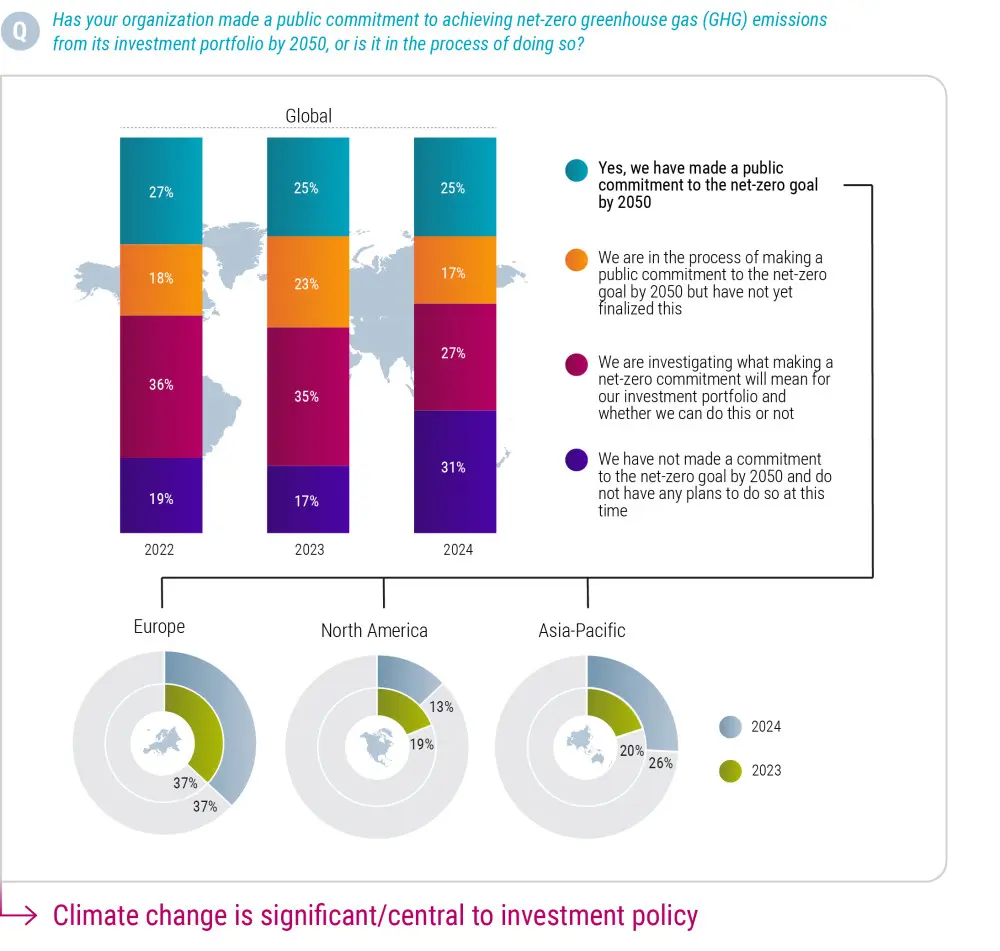Climate investing
Proposed solutions
The solution to climate change can be summed up in one word – decarbonize. Investors serious about climate therefore need to look for net zero solutions. Robeco offers climate-orientated investment strategies; from bespoke net zero funds to more thematic strategies targeting renewable energy and the technology behind it, we’re at the forefront of making the world more sustainable.

Robeco’s Global Climate Survey of 2024 showed that the number of investors globally who have made a firm commitment to net zero remained constant at 25%, rising to 37% of European investors. Commitments in Asia-Pacific rose to 26% of investors, up from 20% in 2023. Some 17% of global investors said they were in the process of evaluating a net zero commitment, and a further 27% were investigating whether it would work for their portfolios. However, interest in North America has declined due to a backlash against ESG investing generally.
There is both the appetite for making a difference and a wealth of solutions available. These fall broadly into four main categories:
Bespoke climate funds that specifically target the equities of companies that can combat global warming, from those in renewable energy and emissions reduction technology to those in related topics such as biodiversity.
Decarbonization funds linked to Paris-aligned benchmarks that look to reduce the carbon footprint of existing high-emitting investments by the 7% a year required to achieve net zero by 2050. These include companies that are currently part of the problem, but which can change to become part of the solution.
Thematic investments that look for wider and more holistic solutions to create a more sustainable world, such as sustainable water, the circular economy, and the ‘smart’ way to look at future energy, mobility and materials. These are explained in more detail below.
Funds that look for companies making contributions to the Sustainable Development Goals (SDGs), one-third of which are directly related to combating climate change, such as SDG 12 (responsible consumption and production).
The sustainable transition
Sustainable transition signifies the biggest intentional change for people and our planet in history. Transition investing targets companies who may be at the beginning of this journey to improve human well-being and combat climate change. This provides numerous investment opportunities. We use forward-looking metrics to identify companies with sustainable potential, and offer investment solutions to seize these opportunities.
How we can generate alpha
In order to navigate the transition investment landscape and generate alpha, we need to understand the direction of travel and identify the winners and losers in this dynamic process. There is a broad universe to assess, as transition investing targets companies who may be at the beginning of their decarbonization journeys.
While regulation is currently driving transition momentum, this journey is set to last several decades. Any company currently preparing for a low-carbon future will have a significant advantage over those that are not. Our investment process recognizes the multiple dimensions of the transition to create robust and resilient investment solutions that understand both the complexity and the longevity of this transition – all with our eyes on the prize of generating alpha.
The transition is about the future and the ability to navigate changing environments - regulatory or otherwise. Both public and private markets are needed to make this happen. Choosing the right investments requires us to develop clear frameworks that embrace the dynamic and multi dimension of transition.
Making it investible
The challenge for professional investors lies in translating transition concepts into investable portfolio assets. This requires a hard look at who qualifies, and on what grounds. As always, getting hold of the right research and data is crucial to find the transition champions.
How companies are deploying and using their capital expenditures to finance a more sustainable future is key. Robeco has decades of experience in understanding just that and making the right investment calls. It’s essential to acquire as much forward-looking data as possible. Emissions data is a good way to track progress, but it is backward-looking. Our SI teams have developed research frameworks that aim to predict future patterns rather than past. Plotting future moves is a new frontier for most asset managers, but Robeco has decades of experience in developing and refining its sustainable investing practices.
Global opportunity, Asia sets the pace
The sustainable transition presents a worldwide opportunity, yet the forefront of combating climate change lies predominantly within Asia. Asia accounts for half of the world’s greenhouse gas emissions and is home to about 60% of the global population. Despite the acute need for Asia’s transition, flows toward these investments have been hampered by limited applicable standards, considering the consider the region’s diverse geographical and economic challenges.
That’s why our emerging markets teams specifically look at Asia, and from a ringside seat from Robeco’s offices in Hong Kong, Shanghai and Singapore. Our local expertise can identify solutions, such as using corporate bonds and green bonds to direct capital to the right places. This doesn’t mean the rest of the world can rest on its laurels. Globally, all companies need to create their own business ecosystems that will help them find their path toward climate‐resilient development.
Read more about transition investingClimate investing is more than just the next big thing
Lucian Peppelenbos (Climate Strategist) and Carola van Lamoen (Head of Sustainable Investing) look at climate change and climate investing from all angles. Listen to the trailer or to the full 25-minute podcast.
The planet’s growing but resources are shrinking
From field to fork, smart farming uses technology to optimize resources, improve yields, reduce waste, conserve biodiversity and increase food security across the food value chain.
More people, less land, less water
The UN estimates that by 2050 human populations will grow to 9.7 billion. That means more than 65 million additional mouths need feeding every year, adding pressure on food and agricultural sectors to produce more to keep pace. Moreover, land is getting even scarcer as populations and cities expand exponentially. The number of megacities – defined as having more than 10 million inhabitants – is increasing worldwide, particularly in developing markets.
Land is not the only critical resource in short supply. As populations boom, so does their water consumption. Global water demand already exceeds supply, with two billion people currently living in areas of acute water stress.
Moreover, water withdrawals are dominated by the agricultural sector, as the water used to produce food is exponentially more than what is used for personal consumption. To illustrate, just one apple requires more than 70 liters of water to produce.
Worldwide, dietary habits are shifting from staples such as roots, tubers and cereal grains towards animal proteins like meat and dairy that demand exponentially greater inputs of water and other resources. Though some of these shifts are healthy and desirable, they are also resource-intensive and costly and intensify pressure on water supplies. For example, producing one kilogram of beef requires 15,000 liters of water.
Environmental challenges
To super-charge crop yields, industrial agriculture has turned to synthetic fertilizers, herbicides and pesticides to stimulate and protect plant growth. However, while effective at improving yields in the short-term, they have also had disastrous long-term effects on the surrounding land and ecosystems. Excess chemicals seep down into natural aquifers and flow into streams, rivers, lakes and ponds, killing native plant species and wildlife.
Moreover, farming and agriculture is acutely vulnerable to the damaging effects of global warming. In some regions, crops are lost to over-precipitation and flooding, whereas in other areas crops suffer due to heat waves and drought. Farmers need to adapt at an accelerated pace to avert crop damage and lost harvests. At the same time, to feed the world without damaging the planet, farmers need to optimize resources and develop climate-smart agricultural practices so that productive and resilient agriculture can be achieved.
Increasing supply, protecting quality
Robust water supplies are essential for agricultural productivity. Many land-locked countries are investing in technologies to capture and clean rainwater. At the other extreme, arid countries with access to ocean waters are investing in desalination plants. Wastewater purification via microfiltration membranes and ultraviolet light are also effective technologies helping regions to counter chronic water shortages.
Furthermore, to transport water to fields and farms, efficient networks of pumps, pipes valves and irrigation systems are needed. Thanks to digitalization, these networks and systems are being equipped with sensors that rapidly detect leaks and breaks, monitor soil moisture levels, and customize water doses according to soil need. In addition, advances in water treatment and analytics are helping identify and extract chemicals, fertilizers, and contaminants from waste and run-off water so that it can be safely returned to the environment or recycled back into the system.
Finally, the importance of water extends beyond hydrating and nourishing crops. Improving soil’s water retention helps restore organic matter and reduce erosion. This leads to more nutritious crops and healthier livestock.
From plants to plates
Ensuring safe water supplies isn’t the only approach to sustainable agriculture. Smart farming’s focus on reducing inputs and protecting soils and vegetation makes it an area ripe for application of circularity principles. GPS technology is already widely used to navigate tractors and harvesters, reducing costs and CO2 emissions associated with operating farming machinery.
Moreover, AI and machine learning can teach agricultural equipment to detect weeds in fields and to automatically apply crop protection chemicals with unprecedented precision and accuracy.
As a result, the volume of chemicals required can be reduced by up to 90%, significantly protecting biodiversity without compromising crop yields.
Population growth, scarce resources and climate change are straining the agricultural sector as well as the environment.
Climate Investing
Striving to keep the global temperature rise to well below 2°C
Robeco’s first sustainable investment portfolio dates back more than 20 years. Today, with solutions from fixed income to equity targeting the long-term effects of global warming, we’re also at the forefront of climate investing.

Clean electrification to drive the global economy to net zero
Getting to net zero in the 21st century and mitigating climate disaster require industry to shift gears, switch fuels and change course.
The expansion of renewables is a powerful catalyst that is enabling the development of clean technologies and solutions across the energy value chain. Mass deployment of solar and wind- power is helping decarbonize electricity generation, and intelligent electrical grids ensure energy demand always matches supply. Grid-connected batteries and green hydrogen will ensure surplus electricity is stored for later use. Moreover, the clean electrification of heavy-carbon emitting areas like passenger mobility, transport logistics and building heat are already underway and gaining momentum.
As electrification spreads and demand for electricity increases, the energy generated will need to be consumed efficiently. Next-generation technologies are helping to reduce energy consumption in power-hungry applications and end-user devices in buildings, industrials, transportation and IT sectors.
Energy meets urgency
Populations and economies need energy. Unfortunately, primary energy supplies are still dominated by hydrocarbons, and global carbon emissions continue to rise. The urgency of climate change has propelled efforts to “green” the global economy, triggering disruptive innovation that is rapidly altering the energy landscape.
Governments worldwide have announced massive new initiatives aimed at decarbonizing entire economies. Prominent among them are strong commitments from the US and China, which are finally aligned with global ambitions to tackle climate change.
Front and center in the race to decarbonize is the carbon-free electricity provided by renewables. Internal projections show that by 2050, solar power generation is likely to increase by a factor of 20, while wind power generation from on and off-shore sources will increase by a factor of 10. This will allow the share of electricity as a percent of global energy consumption to grow from 20% today to 50% by 2050. In parallel, renewables’ share of the electricity mix will nearly triple.
Electrification of transport
The electrification of the transport sector has already developed considerable momentum in recent years and will continue to be an important theme for energy-related investments. Electric vehicle (EV) sales have risen sharply in key markets like Europe and China and should remain strong. Again, internal estimates show global EV sales in 2021 nearly doubling from 2020 which was already an extraordinary year marked by 130% year-on-year growth in Europe and a significant rebound in China towards year end.
The strategies’ investments in transportation are not limited to EV producers; they also cover a whole range of ancillary companies within the EV ecosystem that supply essential parts such as power semiconductors, battery storage, sensors and actuators, as well as EV charging infrastructure.
Electrification of the built environment
Transport is not the only high-emission sector being transformed by electrification; the built environment is also in transition. According to the International Energy Agency, buildings and building construction combined are responsible for over a third of final energy consumption globally and nearly 40% of direct and indirect carbon emissions.
Driven by stricter emission standards and the prospect of lower energy costs, commercial buildings are turning to clean electrification to power and regulate everything from heat pumps and cooling to energy-efficient lighting and building management systems.
Green hydrogen – the missing link
The trend towards electrification is also driving other essential parts of the energy equation. Solar and wind power are clean but also weather dependent and intermittent. Cheap solutions must be created to temporarily store any surplus energy generated. Within passenger transport, lithium ion batteries within electric vehicles are providing cost-effective energy storage solutions; and further improvements are on the horizon.
Larger-scale industries are more energy intensive and difficult to electrify, but even here clean solutions are emerging. Green hydrogen is created by splitting water into hydrogen fuel and oxygen using carbon-free electricity from renewables. As it scales and becomes more cost-competitive, it will provide a critical link in decarbonizing high-carbon emitting industries like long-haul transportation (e.g. trucks, trains, ships and aircraft) and industrial sectors (e.g. semiconductors, fertilizers, and steel production).
Powering up an investment portfolio
Decarbonization of energy goes well beyond the production of solar panels and wind turbines. Reaching net zero in this century will require transformation across the entire energy value chain.

SDG Investing
The UN Sustainable Development Goals are the blueprint for sustainable investing
Set up in 2015 by the UN, the SDGs provide a shared blueprint for peace and prosperity for people and the planet, now and into the future. The SDGs are a perfect way to align investors with broader objectives of society.
